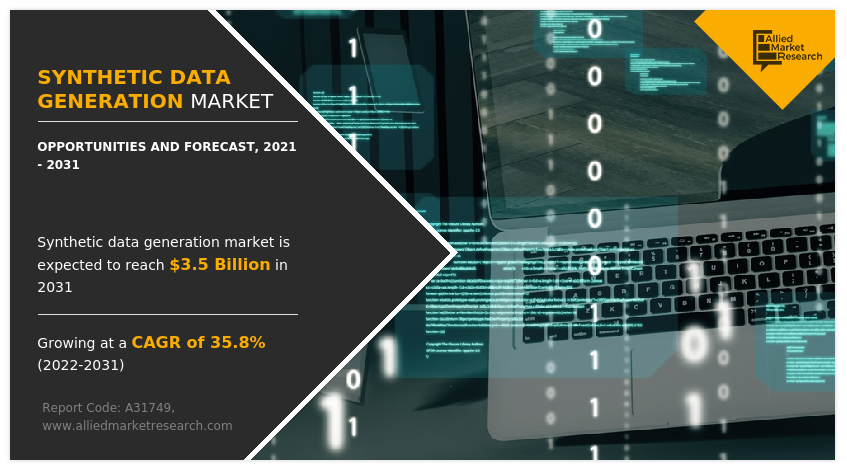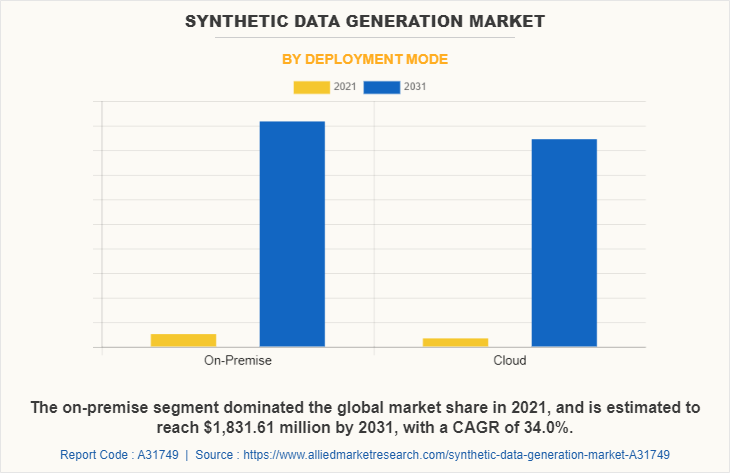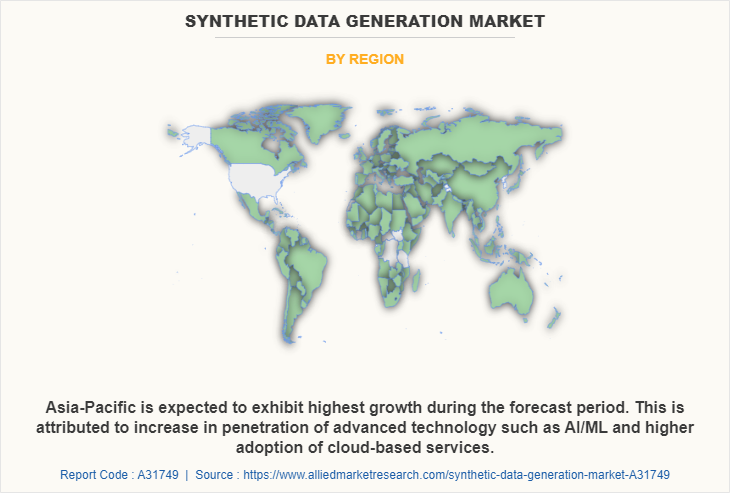Synthetic Data Generation Market Overview
The global synthetic data generation market was valued at USD 168.9 million in 2021, and is projected to reach USD 3.5 billion by 2031, growing at a CAGR of 35.8% from 2022 to 2031.
Surge in digitalization transformation across enterprises and rise in adoption of advanced technology such AI and ML drive the growth of the market. However, lack of skilled workforce hamper the growth of the market. Furthermore, increase in demand for connected devices and IoT and other technologies is expected to provide lucrative growth opportunities for the synthetic data generation market in the upcoming years.

Synthetic data is computer-generated data fast becoming an alternative to real-world data. Instead of being gathered from real-world documentation, computer algorithms generate synthetic data. As advanced AI applications are being developed, companies find it difficult to acquire large quantities of quality datasets for training ML models. However, synthetic data is helping data scientists and developers tide over these challenges and develop highly credible ML models. Such advancement provides the lucrative opportunities for the synthetic data generation market growth in the upcoming year.
On the contrary, engineers often require highly quantitative accurate, and diverse datasets to train and build accurate ML models. Synthetic data helps in reducing the costs of data collection and data labeling. In addition to lowering costs, synthetic raw data helps address privacy issues associated with sensitive real-world data. Furthermore, it reduces bias compared to real data as the developer controls the distribution of synthetic data. It can provide higher diversity by including anomalies that are difficult to source from authentic data. Such benefits create numerous opportunities for market growth during the forecast period.
One of the key benefits that synthetic data could provide is in progressing data testing and sharing capabilities, both internally and externally with other government departments, academia and other sectors. Minimum friction across services will aid collaboration, which will ultimately help to improve services for the consumers.
Moreover, synthetic data will also help to promote data literacy and understanding. It will help to build quick dashboards that can be built on this realistic replica. This data literacy can then help businesses to make more informed decisions. Further, it could also open doors to further data sharing and cross-collaboration, leveraging the benefits of crowd-sourcing innovation, working with industries and academic institutions. In the current landscape these opportunities can be very limited, and require a lot of effort to materialize, thus, likely to drive the growth of the synthetic data generation market.
Top Impacting Factors
Increasing Adoption of Advanced Technologies Such as Artificial intelligence (AI) and machine learning (ML)
Enterprises are using technologically advanced methods to increase operational efficiency. Emerging advanced technologies such as, artificial intelligence (AI), machine learning (ML) and nanotechnologies are driving the growth of the synthetic data generation solutions market. Organizations are taking advantages of new and emerging technologies to mark their presence in the global market, and generate more revenue opportunities.
Furthermore, synthetic data will be a key technology in tackling data management challenges across domains of privacy, predictive analytics, security, and overall data-centricity. AI-powered synthetic data generating algorithms of today digest real data, learn its features, correlations, and patterns in great detail, and are then able to generate infinite amounts of completely artificial, synthetic data matching the statistical qualities of the originally ingested dataset. The modern, synthetic datasets are scalable, privacy-compliant, and contain all of the original meaning without the burden of sensitive information. Such advancements drive the growth of the synthetic data generation industry in the upcoming years.
Enabling the Development of Automotive Sector and Driver Safety Systems
The emerging technology is already an essential component of autonomous driving and computer vision AI systems. Synthetic data combines techniques from the movie and gaming industries (simulation, CGI) with generative neural networks (GANs, VAEs), allowing car manufacturers to engineer realistic datasets and simulated environments at scale without driving in the real world. Synthetic data enables manufacturers to focus on specific objects of interest.
Further, synthetic data generation market trends play an increasingly important role for manufacturers to meet the demands of the in-cabin driver safety monitoring system without tapping into the data of real-world drivers. With increase in concerns around privacy, using synthetic data can increase the driver’s safety without compromising drivers’ privacy.
Furthermore, synthetic data can help automotive manufacturers build robust computer visions systems and give them an edge on monitoring driver behavior. Automotive manufacturers can generate thousands of unique identities using synthetic data with granular control of emotion, gaze angle, head pose, accessories, environments, and camera systems on-demand. Therefore, manufacturers will be able to build more robust training models to monitor large-scale motions such as a driver taking their hands off the wheel and smaller-scale motions such as eye gaze. The massive demand for high-quality synthetic data will continue to push the envelope to meet the demands of the modern connected vehicle, thus driving the growth of the synthetic data generation market.
Segment Review
The synthetic data generation market is segmented on the basis of component, deployment mode, data type, application, industry vertical, and region. By component, it is bifurcated into solutions and services. By deployment mode, it is divided into on-premises and cloud. On the basis of data type, it is categorized into tabular data, text data, image and video data and others. By application, the market is segmented into AI training and development, test data management, data sharing and retention, data analytics and others.
By industry vertical, the synthetic data generation market is categorized into BFSI, IT and telecommunication, government and defense, healthcare and life sciences, manufacturing, transportation and logistics, media & entertainment, manufacturing and others. Region wise, it is analyzed across North America, Europe, Asia-Pacific and LAMEA.

On the basis of deployment mode, the on-premise segment captured the largest synthetic data generation market share in 2021 and is expected to continue this trend throughout the forecast period. This is attributed to the numerous advantages offered by the on-premise deployment such as a high level of data security and safety. Industries prefer on-premise model owing to high data security and less data breach as compared to cloud based deployment models, which further drive the demand for on-premise deployment model within the sectors.
However, cloud segment is expected to exhibit highest growth during the forecast period. Rise in the adoption of cloud-based synthetic data generation due to low cost and easier maintenance drives the growth of the market. In addition, it provides flexibility & scalability to boost business process, which propels the growth of the synthetic data generation market.

By region, North America dominated the market share in 2021 for the synthetic data generation market. The increase in usage of synthetic data generation in BFSI, retail, healthcare and other sectors to improve businesses and the customer experience are anticipated to provide the lucrative growth opportunities for the market in North America. However, Asia-Pacific is expected to exhibit highest growth during the forecast period. This is attributed to increase in penetration of advanced technology such as AI/ML and higher adoption of cloud-based services, propel the market growth in this region.
COVID-19 Impact Analysis
The current estimation of 2031 is projected to be higher than pre-COVID-19 estimates. The global COVID-19 pandemic has drastically affected businesses across the world. It has positively impacted the adoption of synthetic data generation solution due to lockdown imposed by governments of different countries. Post COVID-19 situation, companies are focusing on advanced technology such as artificial intelligence (AI), machine learning (ML), computing technology and analytics across industries such as BFSI, healthcare, IT and telecom and others to perform contactless operation. This factor also create demand for AI-driven synthetic data generation model, which drive the adoption of synthetic data generation market globally.
Moreover, the pandemic has introduced considerable challenges for companies which are trying to execute key processes, report accurately with data spread over multiple locations, operate complex systems, and efficiently communicate with teammates; particularly where there don’t have the infrastructure for such processes. Hence, a greater number of companies are investing in synthetic data generation. Synthetic data generation provides the limitless scalability and continual enhancement of functionality, which are critical in accomplishing digital transformation, which boost the growth of the synthetic data generation market post pandemic.
For instance, the Medicines and Healthcare products Agency (MHRA) has announced the creation of two innovative synthetic datasets which will support the development of cutting-edge medical technologies to fight coronavirus (COVID-19) and cardiovascular disease. These datasets have been generated to mirror symptoms, diagnoses and treatments in genuine patients. Synthetic datasets like these are valuable in the development and testing of machine learning and artificial intelligence (AI) algorithms in medical devices used for diagnosing diseases and monitoring and improving health conditions. Such enhancement provides the lucrative opportunities for the synthetic data generation market forecast.
Key Benefits for Stakeholders
The study provides an in-depth analysis of the synthetic data generation market along with the current trends and future estimations to elucidate the imminent investment pockets.
Information about key drivers, restrains, and opportunities and their impact analysis on the synthetic data generation market size is provided in the report.
The Porter’s five forces analysis illustrates the potency of buyers and suppliers operating in the synthetic data generation industry.
The quantitative analysis of the global synthetic data generation market for the period 2021–2031 is provided to determine the synthetic data generation market potential.
Synthetic Data Generation Market Report Highlights
| Aspects | Details |
| Market Size By 2031 | USD 3.5 billion |
| Growth Rate | CAGR of 35.8% |
| Forecast period | 2021 - 2031 |
| Report Pages | 279 |
| By Component |
|
| By Deployment Mode |
|
| By Data Type |
|
| By Application |
|
| By Industry Vertical |
|
| By Region |
|
| Key Market Players | Gretel Labs, CVEDIA Inc., Datagen, IBM Corporation, Meta, Amazon.com, Inc., Mostly AI, Synthesis AI, NVIDIA Corporation, Microsoft Corporation |
Analyst Review
According to CXOs of the leading companies, over the time, businesses have seen various changes in the business processes, operations, and industrial automation. Moreover, businesses are shifting towards the digital platform and increasing implementation of Industry 4.0 to cope with ongoing tough business competition, which, creates the need for seamless solution and platform to meet these requirements. This increases eventually escalates the adoption of synthetic data generation in manufacturing, healthcare, and among others industry sectors rapidly. Furthermore, the synthetic data generation market is experiencing growth as artificial intelligence (AI) and machine learning (ML) technologies gain popularity in various sectors. The AI-driven technology empowers businesses to keep up-to-date with the latest data, automate repetitive task, internal processes and improve productivity. In addition, it improves customer experience through predictive analytics and automate function where manual processes were previously required, and personalize user-interface capabilities. This offers lucrative growth opportunities for the synthetic data generation market growth in the upcoming years.
On the contrary, AI is driven by the amount, quality, and speed of training data. Synthetic training data is already bolstered in several industries including autonomous vehicles and robotics. There is a critical need for education on the underlying technology and benefits to drive broader industry adoption. Building core synthetic data capability will be the key to whether or not some companies adapt or fall behind in the future. Synthetic data has the potential to deliver perfectly labeled data on-demand, potentially cutting millions of dollars and months of work related to the current process of collecting, preparing, and manually labeling training data.
Nevertheless, prominent market players are exploring new technologies and applications to meet the increase in customer demands. Product launches, collaborations, and acquisitions are expected to enable them to expand their product portfolios and penetrate different regions. Emerging economies provide lucrative opportunities to market players for growth or expansion.
The global synthetic data generation market was valued at USD 168.9 million in 2021, and is projected to reach USD 3.5 billion by 2031.
The global synthetic data generation market is projected to grow at a compound annual growth rate of 35.8% from 2021-2031 to reach USD 3.5 billion by 2031.
Amazon.com, Inc., CVEDIA Inc., Datagen, IBM Corporation, Meta, Microsoft Corporation, Mostly AI, NVIDIA Corporation Synthesis AI and others.
North America is the largest market for synthetic data generation market
Factors such as surge in digitalization transformation across enterprises and rise in adoption of advanced technology such AI and ML drive the growth of the market.
Loading Table Of Content...



